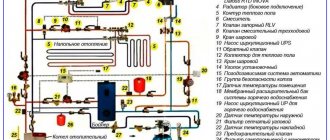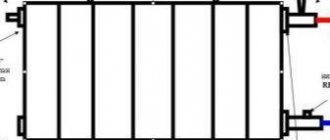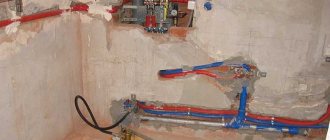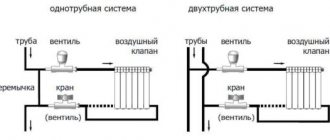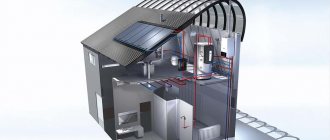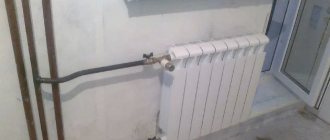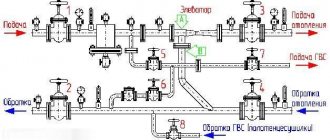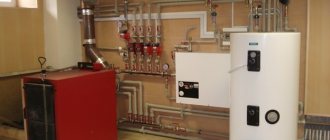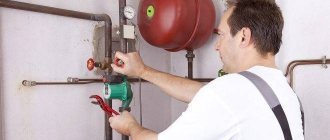In any heating systems used for heating individual cottages and dachas, mud deposits accumulate over time, interfering with their functioning. To bring them to a state of operation with the best efficiency, flushing the heating system in a private house is used.
Typically, many homeowners perform these procedures with their own hands without calling specialists. In this case, they should know the various options and technology for carrying out the work, and the equipment used.
Rice. 1 Main components and diagram of a domestic heating system for a private house
How and how to flush radiators and heating systems
The process of cleaning the heating system of a house is not complicated; any owner can handle it.
There are several ways to clean the heating network in a private home with your own hands.
- mechanical flushing;
- dry cleaning;
- hydropneumatic flushing;
- pneumohydraulic hammer method;
- biological washing.
Mechanical flushing
This method of flushing heating systems requires complete disassembly of all communications - before cleaning the elements, you will have to remove every part of the system. The complexity of the method lies in cleaning the internal surfaces of pipes and batteries from scale and rust manually using metal brushes. Nowadays, it is practically not used, as it requires a significant investment of time and effort.
Dismantling for mechanical flushing of the heating system
Chemical washing method
To clean the system, you need to connect a pump with a container filled with chemicals. The detergent dissolves and loosens contaminants stuck to the pipe walls.
For chemical cleaning, two types of liquids are used - acid or alkaline based, used depending on the material from which the pipes and batteries are made, as well as the type of deposits. It is recommended to flush the heating system with chemicals also in cases where it is too difficult to remove the system elements.
Alkali- or acid-based cleaning fluid cannot be used when working with aluminum batteries due to the fact that the metal reacts with chemical compounds. It is also prohibited to clean depressurized systems, since the chemical cleaning agent is toxic and can cause harm to health.
. For the same reason, used liquids should not be poured down the drain, and work should be performed with rubber gloves and a respirator.
Chemical washing
After chemical cleaning, all contaminants will be completely removed, extending the life of the system.
Hydropneumatic flushing
This method involves treating the internal surfaces of batteries and pipes with a flow of a mixture of air and water supplied under high pressure. Flushing the heating system in this way is highly effective, but its use requires special equipment.
Hydropneumatic cleaning has proven itself excellent when working with cast iron radiators of the old type, still made in the Soviet Union. Cleaning with water and air does not impose any strict requirements on the elements of the heating system, like a chemical method, that is, it is equally suitable for all types of materials and pipes. Despite the high cost compared to the chemical method, it is completely safe and more effective.
Equipment connected to the elevator for hydropneumatic washing
Before cleaning, it is recommended to treat batteries using a special composition that softens the crust of contaminants.
Pneumohydraulic hammer method
This method is the fastest (takes no more than an hour), convenient, since you do not have to dismantle the elements of the system, but requires the use of special equipment.
At the end of the heating communications, special equipment is attached - a pneumatic gun, with the help of which a pneumohydraulic pulse is supplied to the pipeline, peeling off pollutants adhering to the walls of pipes and batteries.
Despite the serious and frighteningly complex name, flushing pipes in this way is absolutely safe, since a force of no more than 2% of the pulse power is applied to the walls, and the main impact falls on the dirt.
Operating principle of pneumatic hydraulic shock
Biological washing
At its core, this method is very similar to the chemical one, only instead of dangerous reagents, high-tech solvents and proppant biological products are used. Under their influence, the crystalline bonds of pollutants are destroyed and corrosive and organic deposits are cleaned off.
The flushing biomaterial is produced on a water basis, and their use allows you to completely clean the heating network in an apartment building and in an individual home.
The process of cleaning pipes with flushing biomaterial
Instead of an epilogue
Currently, purchasing a cleaner for the heating system does not present any difficulty - you can find it in any hardware store. The main thing is to choose the right type so that it can come into contact with the material of the pipeline being processed without negative consequences. You should also carefully study the instructions for use to determine the need to use protective gloves and other equipment. Regarding sources of purchase: experts advise purchasing the cleaner at retail if you need to do a small amount of work. In other cases, it is better to buy products through online platforms, then it will be possible to save on large volumes of packaging.
How to temporarily remove a heating radiator
This article is about how to temporarily remove a heating radiator. to replace it or paint the wall behind it. Removing the radiator is not at all difficult, as it might seem at first glance; we will talk about this in the article. First of all, you must understand the consequences of a failed attempt to remove the radiator: if you do not know how to remove the radiator correctly, a leak may subsequently appear and you will ruin the flooring
However, if you pay attention to our tips, you will eliminate all problems at once during the radiator removal process
First of all, we must show you the main elements of the radiator: at the top right - the control valve, at the bottom left - the shut-off valve (for regulating the water supply), at the top left - the Mayevsky valve for bleeding air from the heating radiator.
Using a control valve, you can adjust the flow of incoming water into the radiator by opening or closing the valve, you will regulate its heating temperature by increasing and decreasing it accordingly. Using the shut-off valve, you can adjust the intensity at which the water will flow out. Most often, such a valve is used to balance all radiators and is installed on each one.
First of all, close the valves. The adjusting one is closed by hand, and the locking one is closed using a hex key.
TIP: When you close the shut-off valve, remember how many turns you made so that you can then open it the same amount.
Now you need to disconnect the radiator from the valves. To do this you will need a wrench or a gas wrench. The faucet structure consists of an American type (removable coupling). Unscrew the American nut to separate the radiator from the valve.
TIP: To avoid damaging the flooring, place unnecessary rags under the radiator.
Unscrew the shut-off valve...
We unscrew the control valve in the same way... For reliability, use a second wrench to hold the American fitting while unscrewing the nut.
The last step is to remove the radiator from the brackets. The best advice we can give you is that you remove the radiator with someone, as a radiator with water is very heavy. This operation requires at least two people.
ADVICE. If you will be painting the wall behind the radiator, seal the valves in bags or paper.
During the process of painting or gluing the wall, place the radiator so that it does not get scratched. When you are finished painting, hang the new radiator you bought or the old one on the brackets.
With the radiator hanging in place, connect the valve and radiator using an American tie rod. When tightening the shut-off valve, remember the number of turns you had to turn to close it and open it exactly the same amount.
Open the control valve to supply coolant, while you need to open the Mayevsky tap so that air comes out through it and the radiator is filled with water. After water drips from the Mayevsky tap, turn it off, this will mean that the radiator is filled with coolant.
Thanks for reading our article on how to temporarily remove a radiator. and our other articles. Don't forget to Love our projects and share them with your friends using social widgets.Water hammer cleaning
Water hammer technology is used mainly for flushing old networks made of cast iron pipes and radiators. This requires special equipment to provide the required pressure.
The process consists of the following steps:
- The system is completely drained of water.
- Identify areas where blockages are suspected to have formed. In these places, pieces of pipes are dismantled.
- A hose with a special nozzle is inserted into the line. A stream of water is supplied through it under pressure. The duration of the procedure is approximately 50 – 60 minutes. During this time, all deposits inside the channels are broken down.
- The procedure is completed by flushing the system with clean water. To do this, remove all installed filters from the pipes, fill in water and drain it completely. This helps rid the pipes of plaque residue.
Expert opinion Vadim Savelievich Grebnev Heating systems installer
If the heating system has check valves, they must be closed, bypassed or temporarily removed. Otherwise, it will prevent the flow from reversing.
Chemical cleaning methods
The most impressive results are obtained by using chemical compounds; moreover, such cleaning is the least labor-intensive. However, most products for flushing a heating system with a gas boiler are based on acids, which can destroy not only plaque, but also metal.
Therefore, this cleaning method is used where others cannot cope, and as rarely as possible.
Chemical cleaning restores pipes to almost new condition, some compounds will provide protection for 1-3 seasons, but leaks may open in places of greatest damage
When choosing a chemical wash, pay attention to the following points:
- Compatible materials. Owners of aluminum radiators should be especially careful - most compounds are unacceptable for them, but specialized solutions exist.
- Proportions and time of use. Running a too concentrated solution into the system, or for too long a period, will most likely damage it.
- Type of deposits. Remember, the more types of deposits a product can remove, the greater the likelihood of damage to pipes, radiators, and gaskets at connections.
- The need for recycling. Many compounds are prohibited from being poured down the drain, and collecting, removing and processing such a volume of liquid can become a problem.
How to use the composition for chemical cleaning of the heating system is described in detail in its instructions. In most cases, it is necessary to drain the coolant, prepare a solution from the same volume of water and reagent, mix well, pour into the system and put it into operation.
As a rule, the composition should circulate through the circuit for 2 to 24 hours, after which it must be drained, and the entire system should be rinsed with clean running water and filled with new coolant.
Please note that the coolant with the reagent must always circulate through the system forcibly, under pressure - that is, through a pump. For chemical washing of a separate area, you will need a special pump with a container, which, using hoses, provides a small circle of circulation
For chemical washing of a separate area, you will need a special pump with a container, which, using hoses, provides a small circle of circulation
It is also possible to clean part of the heating circuit with the reagent, including the boiler heat exchanger. In this case, it is advisable to carry out flushing in the direction opposite to the normal flow of the coolant.
Among the types of chemical cleaning, it is worth highlighting microbiological and dispersed. They differ only in the compositions used: in the first case, they are of biological origin and do not require special disposal.
Dispersive washing is a new, advanced technology in which the bonds of sediment particles are destroyed, and the metal does not react.
After dispersed washing, a film is formed inside the pipes and radiators, preventing contact of the metal with water and its oxidation, and also reducing friction resistance. According to the manufacturers, this film is preserved for 3 seasons, which means that during this period your heating system will not become clogged.
Signs of scale on the inner surface of pipes
The main reason to think that heating radiators need to be flushed is the appearance of the following signs:
- increasing energy consumption to achieve the usual indoor temperature;
- noticeable to the touch difference in temperature of radiators and pipes suitable for them;
- uneven heating of radiators, when their upper part becomes much hotter than the lower;
- when the heating boiler is operating, extraneous noise or crackling appears;
- increased heating time for the heating system.
Details on how to flush a well with your own hands: causes of blockage, cleaning options, prices.
How to clean soot from a boiler at home: step-by-step instructions.
How to make a two-pipe heating system for a private house with your own hands.
Contamination may also appear after replacing radiators. In this case, their source becomes unnoticed debris in new batteries.
What will you need?
To flush your heating system yourself without disassembling the radiators, you will need specialized equipment (CIF), which is called cleaning in place. It is necessary for the pump to give direction to the movement of fluid in the system. The installation is a plastic container with a pump. In addition, you will need a cleaning solution. It will be poured into the tank and the system will be filled using a pump.
Such equipment is selected based on several factors.
- The cleaning system must be automatic with pulse control for flushing.
- The product body must be resistant to the use of various disinfectants.
- Size and weight are important, because with large dimensions it will be difficult to use the equipment. The optimal option will weigh 7-8 kg.
- It is desirable that the device has an indicator of water pressure and flow, and a flow reverse.
- The container should hold between 10-20 liters.
If you plan to mechanically clean radiators, you need to prepare containers for draining dirty liquid, unnecessary old rags that absorb moisture well, as well as polyethylene so as not to harm the floor covering at the cleaning site or while moving the radiator for washing. In addition, you will need keys, a gas burner or kerosene lamp, a hose to match the size of the heating pipe, a cleaning cable and an iron brush. When using the chemical method, you will need a reagent that does not destroy batteries, a compressor, or an apparatus for introducing liquid into the heating system. Choose a reliable machine; cost savings in this case may affect the quality of washing. This takes into account the type of cleaning material used.
Why does pollution appear?
Corrosion is considered to be the problem with clogging of pipelines made of metal. Accumulating in the middle of the system, it interferes with the free circulation of the coolant, and as a consequence, interruptions occur in the operation of the water-type heating system.
As for plastic pipes, they are naturally not prone to rust, but still, scale appears on their walls, which also helps the heating system malfunction.
One of the causes of pollution is also considered to be the quality of water, which contains various impurities that are the basis for clogging of pipes.
Similarly, there are the following blockage options:
Powders
G63
The powder removes scale from the heating system. The finished solution is compatible with cast iron, metal, and aluminum surfaces. When saturated with scale, the solution turns brown. The product is used in a concentration of 25–100 g/l of water. Washing is carried out at a temperature of 30...40 °C.
Price: from 61$/2 kg.
Descaling powder - G63
pros
- with corrosion inhibitor;
- contains a scale saturation indicator;
- suitable for steel;
- The line includes an acidity neutralizer;
- contour processing in 45 minutes.
Minuses
high price.
SteelTEX ZINC
The drug is compatible with most metals used in heating systems, enameled surfaces and zinc. Before pouring the finished solution into the system, mix it with water until a concentration of 7–15% is achieved; more powder is added during the washing process. The composition includes an indicator of residual acidity. It is recommended to use it with a neutralizer of the same line, which will enhance protection against metal oxidation.
Price: from 4557 rub./5 kg.
SteelTEX ZINC
pros
- the solution can be poured into the sewer;
- compatible with most metal surfaces;
- anti-corrosion protection.
Minuses
No.
SteelTEX ZINC
Causes of pollution
Corrosion is considered to be a common cause of clogging of iron lines. It accumulates in the middle of the system and does not allow fluid to circulate freely. As a result, interruptions occur in the operation of heating systems.
Plastic pipes do not rust, but scale can still form on the walls, which also interferes with the constant operation of the heating system.
Also, the appearance of contaminants is influenced to a certain extent by the quality of water, which contains various impurities.
Therefore, it is necessary to distinguish the following types of blockages:
How and how to flush radiators and heating systems
The process of cleaning the heating system of a house is not complicated; any owner can handle it.
There are several ways to clean the heating network in a private home with your own hands.
:
- mechanical flushing;
- dry cleaning;
- hydropneumatic flushing;
- pneumohydraulic hammer method;
- biological washing.
Mechanical flushing
This method of flushing heating systems requires complete disassembly of all communications - before cleaning the elements, you will have to remove every part of the system. The complexity of the method lies in cleaning the internal surfaces of pipes and batteries from scale and rust manually using metal brushes. Nowadays, it is practically not used, as it requires a significant investment of time and effort.
Chemical washing method
To clean the system, you need to connect a pump with a container filled with chemicals. The detergent dissolves and loosens contaminants stuck to the pipe walls.
For chemical cleaning, two types of liquids are used - acid or alkaline based, used depending on the material from which the pipes and batteries are made, as well as the type of deposits. It is recommended to flush the heating system with chemicals also in cases where it is too difficult to remove the system elements.
Alkali- or acid-based cleaning fluid cannot be used when working with aluminum batteries due to the fact that the metal reacts with chemical compounds. It is also prohibited to clean depressurized systems, since the chemical cleaning agent is toxic and can cause harm to health.
. For the same reason, used liquids should not be poured down the drain, and work should be performed with rubber gloves and a respirator.
After chemical cleaning, all contaminants will be completely removed, extending the life of the system.
Hydropneumatic flushing
This method involves treating the internal surfaces of batteries and pipes with a flow of a mixture of air and water supplied under high pressure. Flushing the heating system in this way is highly effective, but its use requires special equipment.
Hydropneumatic cleaning has proven itself excellent when working with cast iron radiators of the old type, still made in the Soviet Union. Cleaning with water and air does not impose any strict requirements on the elements of the heating system, like a chemical method, that is, it is equally suitable for all types of materials and pipes. Despite the high cost compared to the chemical method, it is completely safe and more effective.
Before cleaning, it is recommended to treat batteries using a special composition that softens the crust of contaminants.
Pneumohydraulic hammer method
This method is the fastest (takes no more than an hour), convenient, since you do not have to dismantle the elements of the system, but requires the use of special equipment.
At the end of the heating communications, special equipment is attached - a pneumatic gun, with the help of which a pneumohydraulic pulse is supplied to the pipeline, peeling off pollutants adhering to the walls of pipes and batteries.
Despite the serious and frighteningly complex name, flushing pipes in this way is absolutely safe, since a force of no more than 2% of the pulse power is applied to the walls, and the main impact falls on the dirt.
Biological washing
At its core, this method is very similar to the chemical one, only instead of dangerous reagents, high-tech solvents and proppant biological products are used. Under their influence, the crystalline bonds of pollutants are destroyed and corrosive and organic deposits are cleaned off.
The flushing biomaterial is produced on a water basis, and their use allows you to completely clean the heating network in an apartment building and in an individual home.
TOP powdered substances
BWT Cilit Neutra P
A powder substance that is used to neutralize an acid solution after flushing the heating with a chemical liquid. Before use, you must dilute the product in water; during this process, you must follow the instructions.
The average price is 3,700 rubles.
BWT Cilit Neutra P
Advantages:
- Cost-effective, since a small volume of powder can neutralize tens of liters of acid;
- Sold in durable packaging, which makes the product easy to store and transport;
- Effective acid neutralization.
Flaws:
- Not found.
SteelTEX ZINC
Concentrated powder that can effectively clean heating elements from traces of various contaminants. Used for both home and professional purposes. Compatible with all main materials used in the production of radiators.
The average price is 5,300 rubles.
SteelTEX ZINC
Advantages:
- Contains strong acids;
- Durable and convenient packaging;
- Does not cause corrosion;
- Easy to use.
Flaws:
- High price.
Method for performing centralized battery cleaning
To clean cast iron batteries properly, you will have to contact a utility service or a special construction company. In this case, the hydropneumatic method is used for flushing. At the same time, water is supplied to the riser under strong pressure. Compressors operating intermittently supply air to the system, which is mixed with water. The air-saturated liquid is fed into the system, where microbubbles hit the walls of the batteries and break off microparticles of debris and dirt. Thus, blockages are gradually washed out of the batteries and channels.
Although this method is considered quite effective, it requires some preparation. However, before washing cast iron batteries, they will not need to be dismantled. However, some owners prefer not to waste time and effort on coordinating with neighbors and ordering services from the utility service, but simply remove the radiator and clean it themselves.
Device for washing the heat exchanger
Prevention of gas boilers - flushing heat exchangers
To wash the heat exchanger with your own hands photo
Buy Cillit SEK 28 20l/8m at a price of 0 rub. with free delivery to shopping mall in St. Petersburg
Device for reagent washing of equipment SEK, BWT - catalog KOMFORT.RU
BWT Cillit-KalkEx-Mobil 60, Cillit KalkEx Mobile, 60007. Installation for washing, cleaning, heat exchanger and descaling
Equipment for washing heat exchangers Master plumber
"Teplostandard" - Heating Water supply Installation, Oventrop, Pumps and reagents for heat exchangers
Washing heat exchangers with hydrochloric acid
Romatic 20 flushing pump for descaling order inexpensively in Moscow from - Regma
Rothenberger Compressor for washing Rothenberger ROPULS 1000000145, price - Consumer goods - Compressor for washing
Cleaning pump DOS40 V4V 7786 - $1,049.00. Profil.fi hybrid heating systems, heat pumps, dry closets, profil.fi
Pumps and chemicals (reagents) BWT, buy equipment for washing heat exchangers
Safety articles » Press releases » Press release from GEL - prices for equipment for flushing and cleaning heat exchangers
Installations, pumps for washing heat exchangers, boosters. Buy - Bboard
ANVITEK brazed heat exchanger design
Do-it-yourself flushing of a gas boiler heat exchanger About repairs
Do-it-yourself installation for washing heat exchangers
Washing plate heat exchangers, cleaning the boiler heat exchanger
Pump Eliminate Flea, Pump Eliminate Flea V4V Pumping units for cleaning the heat exchanger and servicing boilers of heating systems
Buy pumps for washing heat exchangers, installation for washing heat exchangers
Popular:
- Installation of LED strip on a suspended ceiling
- Wind compressor for pond
- Stationary generator repair
- How to make a soft hedgehog toy
- Reel for a speargun
- Refractory mortar for laying stoves
Rating of solutions that are immediately ready for use
Perkhim Medesk
Sold in a canister (20 liters) and is suitable for organizing effective flushing of the heating system. It is used by many professionals as the main remedy, since it contains excellent components that can remove scale and dirt in a short period.
The average price is 4,330 rubles.
Perkhim Medesk
Advantages:
- Good cleaning;
- Easy to use, as there is no need to dilute anything;
- Does not affect metal elements.
Flaws:
Price issue
From a financial point of view, the least burdensome way to clean your heating system is to do all the work yourself. In this case, the total costs will not exceed several hundred rubles. You will have to purchase consumables and tools:
- brush,
- brush,
- sealing tape or linen.
If you order cleaning from a specialized company, the cost of the work will depend on the technology chosen.
As a rule, comprehensive cleaning will cost from 6,000-8,000 rubles.
Washing one heating battery - from 800 rubles. This cost will include both the work itself and the solution of organizational issues: how to flush the heat exchanger at home, what technology will be used, etc.
